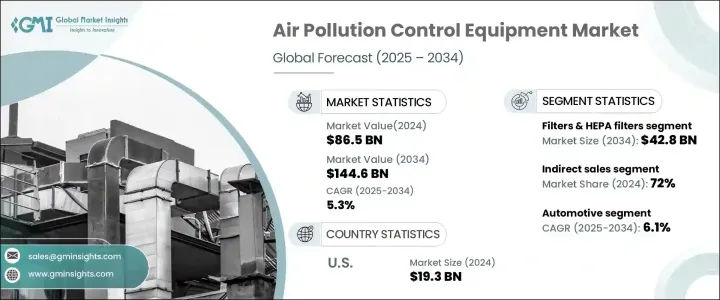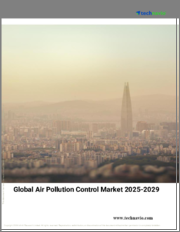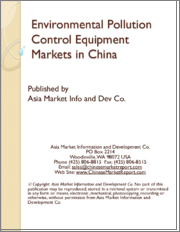
|
시장보고서
상품코드
1699419
대기오염 방지 장비 시장 기회, 성장 촉진요인, 산업 동향 분석, 예측(2025-2034년)Air Pollution Control Equipment Market Opportunity, Growth Drivers, Industry Trend Analysis, and Forecast 2025-2034 |
||||||
세계 대기오염 방지 장비 시장은 2024년 865억 달러 규모로 2025년부터 2034년까지 CAGR 5.3%로 성장할 것으로 예상됩니다.
이러한 성장의 배경에는 엄격한 환경 규제, 산업 활동의 활성화, 대기오염이 건강에 미치는 악영향에 대한 대중의 인식이 높아진 것이 있습니다. 세계 각국 정부는 더욱 엄격한 배출 규제를 시행하고 있으며, 산업계는 더 깨끗한 기술을 채택하고 지속가능한 관행을 시행하도록 강요하고 있습니다. 대기오염이 공중 보건에 심각한 문제로 대두되면서 기업들은 규제 기준을 준수하고 기업의 지속가능성 이니셔티브를 강화하기 위해 첨단 여과 및 정화 시스템에 많은 투자를 하고 있습니다.

제조, 에너지, 운송 등의 산업은 대기오염의 가장 큰 원인 중 하나이며, 규제 기관이 배출량 감축 목표를 강제하도록 촉구하고 있습니다. 입자상 물질, 휘발성 유기화합물(VOC), 온실가스와 같은 유해한 오염물질을 최소화하도록 설계된 기술은 빠르게 채택되고 있습니다. 또한, 신흥 경제국의 도시화와 산업화가 진행됨에 따라 효과적인 대기오염 방지 솔루션의 필요성이 증가하고 있습니다. 친환경 인프라에 대한 투자와 함께 스마트 시티의 확장은 시장 성장을 더욱 촉진하고 있습니다. 여과, 정전기 침전, 촉매 변환 기술의 발전으로 대기오염 방지 장비의 효율성과 비용 효율성이 향상되어 공공 및 민간 부문의 투자를 유치하고 있습니다. 또한, 사물인터넷(IoT) 기반 모니터링 시스템의 통합이 확산되면서 대기 질과 장비의 성능을 실시간으로 추적할 수 있게 되었습니다.
| 시장 범위 | |
|---|---|
| 시작 연도 | 2024년 |
| 예측 연도 | 2025-2034년 |
| 시작 금액 | 865억 달러 |
| 예상 금액 | 1,446억 달러 |
| CAGR | 5.3% |
시장은 필터 및 HEPA 필터, 스크러버, 촉매 컨버터, 전기 집진기, 미스트 컬렉터, 산화제, 기타 기술 등 다양한 유형으로 구분되며, 2024년 필터 및 HEPA 필터 분야는 미립자 물질의 높은 포집 효율로 인해 미립자 물질의 미립자 물질의 높은 포집 효율로 우위를 유지했습니다. 이러한 필터는 산업, 상업, 주거용으로 널리 사용되고 있으며, 특히 의료 환경에서 높은 수요를 보이고 있습니다. 병원, 연구소, 제약 제조 시설에서는 무균 공기가 필요하며, 고성능 HEPA 필터의 채택을 촉진하고 있습니다. 공기 감염에 대한 우려가 높아지고 호흡기질환의 유병률이 증가함에 따라 시장 수요가 더욱 가속화되고 있습니다.
대기오염 방지 장비 시장은 판매 채널에 따라 직접 판매와 간접 판매로 분류되며, 2024년에는 간접 판매가 전체 매출의 72%를 차지했으며, 2025년부터 2034년까지 CAGR 5.1%로 성장할 것으로 예상됩니다. 이 분야는 E-Commerce 플랫폼의 부상으로 공기청정기가 소비자와 기업에게 더 친숙한 존재가 되면서 수혜를 입고 있습니다. 소매 네트워크와 온라인 시장의 확대는 유통 프로세스를 간소화하고 구매자에게 경쟁력 있는 가격으로 다양한 솔루션을 제공하고 있습니다. 디지털 전환이 산업 부문을 재편하고 있는 가운데, 온라인 구매의 용이성과 제품 정보의 접근성은 간접 채널을 통한 판매를 촉진하고 있습니다.
미국 대기오염 방지 장비 시장은 2024년 193억 달러로 2025년부터 2034년까지 연평균 5.3%의 성장률을 보일 것으로 예상됩니다. 미국 시장의 성장은 엄격한 환경법, 특히 엄격한 배출가스 규제를 의무화하는 대기정화법의 영향을 크게 받고 있습니다. 발전, 화학, 제조 등의 산업 부문이 지속적으로 확대되면서 고도의 오염 방지 기술에 대한 수요가 증가하고 있습니다. 친환경 에너지 및 친환경 산업 공정에 대한 투자가 증가함에 따라 기업들은 환경 영향을 줄이기 위해 연방 및 주정부 규정을 준수하는 것을 우선순위로 삼고 있습니다.
목차
제1장 조사 방법과 조사 범위
- 시장 범위와 정의
- 기본 추정과 계산
- 예측 계산
- 데이터 소스
- 1차
- 2차
- 유료 소스
- 공적 소스
제2장 주요 요약
제3장 업계 인사이트
- 업계 생태계 분석
- 주요 뉴스와 이니셔티브
- 제휴/협력
- 합병/인수
- 투자
- 제품 발표와 혁신
- 성장 촉진요인
- 자동차 배출량 증가
- 기술의 진보
- 업계의 잠재적 리스크·과제
- 높은 초기 비용과 빠르게 변화하는 기술
- 규제 상황
- 기술 개요
- 잠재 성장력 분석
- 무역 분석
- Porters 분석
- PESTEL 분석
제4장 경쟁 구도
- 소개
- 기업 시장 점유율
- 주요 시장 기업 경쟁 분석
- 경쟁 포지셔닝 매트릭스
- 전략 전망 매트릭스
제5장 시장 추정과 예측 : 유형별, 2021-2034년
- 주요 동향
- 스크러버
- 미스트 콜렉터
- 촉매 컨버터
- 필터·HEPA 필터
- 전기 집진기
- 산화 장비
- 열산화 장비
- 촉매 산화 장비
- 재생열산화 장비
- 기타(활성탄 흡착, 배연탈황(FGD) 시스템 등)
제6장 시장 추정과 예측 : 용도별, 2021-2034년
- 주요 동향
- 자동차
- 화학 프로세스
- 식품 및 음료 산업
- 야금
- 광업
- 제약
- 시멘트·골재
- 기타
제7장 시장 추정과 예측 : 유통 채널별, 2021-2034년
- 주요 동향
- 직접 판매
- 간접 판매
제8장 시장 추정과 예측 : 지역별, 2021-2034년
- 주요 동향
- 북미
- 미국
- 캐나다
- 유럽
- 영국
- 독일
- 프랑스
- 이탈리아
- 스페인
- 아시아태평양
- 중국
- 인도
- 일본
- 한국
- 호주
- 라틴아메리카
- 브라질
- 멕시코
- 중동 및 아프리카
- 사우디아라비아
- UAE
- 남아프리카공화국
제9장 기업 개요
- Donaldson
- FLSmidth
- GEA Group
- Lydall
- MANN+HUMMEL
- Mitsubishi Power
- Nederman
- Pall
- Siemens
- Thermax
The Global Air Pollution Control Equipment Market generated USD 86.5 billion in 2024 and is projected to grow at a CAGR of 5.3% from 2025 to 2034. This growth is fueled by stringent environmental regulations, rising industrial activities, and increasing public awareness of air pollution's adverse health effects. Governments worldwide are imposing stricter emission controls, compelling industries to adopt cleaner technologies and implement sustainable practices. With air pollution becoming a critical public health concern, businesses are investing heavily in advanced filtration and purification systems to comply with regulatory standards and enhance corporate sustainability initiatives.

Industries such as manufacturing, energy, and transportation are among the largest contributors to air pollution, prompting regulatory bodies to enforce emission reduction targets. Technologies designed to minimize harmful pollutants, including particulate matter, volatile organic compounds (VOCs), and greenhouse gases, are witnessing rapid adoption. Additionally, growing urbanization and industrialization in developing economies are amplifying the need for effective air pollution control solutions. The expansion of smart cities, coupled with investments in eco-friendly infrastructure, is further bolstering market growth. Advancements in filtration, electrostatic precipitation, and catalytic conversion technologies are making air pollution control equipment more efficient and cost-effective, attracting both public and private sector investments. The integration of IoT-enabled monitoring systems is also gaining traction, allowing real-time tracking of air quality and equipment performance.
| Market Scope | |
|---|---|
| Start Year | 2024 |
| Forecast Year | 2025-2034 |
| Start Value | $86.5 Billion |
| Forecast Value | $144.6 Billion |
| CAGR | 5.3% |
The market is segmented into various types, including filters and HEPA filters, scrubbers, catalytic converters, electrostatic precipitators, mist collectors, oxidizers, and other technologies. In 2024, the filters and HEPA filters segment generated USD 24.6 billion, maintaining its dominance due to its efficiency in capturing fine particulate matter. These filters are widely used across industrial, commercial, and residential applications, with healthcare settings seeing particularly high demand. The need for sterile air in hospitals, laboratories, and pharmaceutical manufacturing facilities is driving the adoption of high-performance HEPA filters. Rising concerns over airborne diseases and the increasing prevalence of respiratory disorders are further accelerating market demand.
The air pollution control equipment market is also categorized by sales channels into direct and indirect sales. In 2024, indirect sales accounted for 72% of the total revenue and are expected to grow at a CAGR of 5.1% between 2025 and 2034. This segment benefits from the rise of e-commerce platforms, which have made air purification products more accessible to consumers and businesses. The expansion of retail networks and online marketplaces is streamlining the distribution process, offering buyers a wider range of solutions at competitive prices. As digital transformation continues to reshape the industrial sector, the ease of online purchasing and availability of product information are driving sales through indirect channels.
The U.S. air pollution control equipment market was valued at USD 19.3 billion in 2024 and is projected to grow at a CAGR of 5.3% between 2025 and 2034. Growth in the U.S. market is largely influenced by stringent environmental laws, particularly the Clean Air Act, which mandates strict emissions controls. The ongoing expansion of industrial sectors, including power generation, chemicals, and manufacturing, is fueling demand for advanced pollution control technologies. With rising investments in green energy and eco-friendly industrial processes, businesses are prioritizing compliance with federal and state regulations to mitigate environmental impact.
Table of Contents
Chapter 1 Methodology & Scope
- 1.1 Market scope & definition
- 1.2 Base estimates & calculations
- 1.3 Forecast calculation
- 1.4 Data sources
- 1.4.1 Primary
- 1.4.2 Secondary
- 1.4.2.1 Paid sources
- 1.4.2.2 Public sources
Chapter 2 Executive Summary
- 2.1 Industry 360º synopsis, 2021 - 2034
- 2.2 Business trends
- 2.3 Regional trends
- 2.4 Product type trends
- 2.5 Distribution channel trends
Chapter 3 Industry Insights
- 3.1 Industry ecosystem analysis
- 3.2 Key news and initiatives
- 3.2.1 Partnership/Collaboration
- 3.2.2 Merger/Acquisition
- 3.2.3 Investment
- 3.2.4 Product launch & innovation
- 3.3 Growth drivers
- 3.3.1 Rising Automotive Emissions
- 3.3.2 Technological Advancements
- 3.4 Industry pitfalls & challenges
- 3.4.1 High initial costs & rapidly changing technologies
- 3.5 Regulatory landscape
- 3.6 Technological overview
- 3.7 Growth potential analysis
- 3.8 Trade analysis
- 3.9 Porter's analysis
- 3.10 PESTEL analysis
Chapter 4 Competitive Landscape, 2024
- 4.1 Introduction
- 4.2 Company market share, 2024
- 4.3 Competitive analysis of major market players, 2024
- 4.4 Competitive positioning matrix, 2024
- 4.5 Strategic outlook matrix, 2024
Chapter 5 Market Estimates & Forecast, By Type 2021 – 2034, (USD Billion) (Million units)
- 5.1 Key trends
- 5.2 Scrubber
- 5.3 Mist collector
- 5.4 Catalytic Converters
- 5.5 Filters & HEPA Filters
- 5.6 Electrostatic precipitator
- 5.7 Oxidizers
- 5.7.1 Thermal oxidizers
- 5.7.2 Catalytic oxidizers
- 5.7.3 Regenerative thermal oxidizers
- 5.8 Others (Activated Carbon Adsorption, Flue Gas Desulfurization (FGD) Systems, etc.)
Chapter 6 Market Estimates & Forecast, By Application 2021 – 2034, (USD Billion) (Million units)
- 6.1 Key trends
- 6.2 Automotive
- 6.3 Chemical processing’s
- 6.4 Food & beverage industry
- 6.5 Metallurgical
- 6.6 Mining
- 6.7 Pharmaceuticals
- 6.8 Cement & aggregates
- 6.9 Others
Chapter 7 Market Estimates & Forecast, By Distribution Channel 2021 – 2034, (USD Billion) (Million units)
- 7.1 Key trends
- 7.2 Direct sale
- 7.3 Indirect sale
Chapter 8 Market Estimates & Forecast, By Region 2021 – 2034, (USD Billion) (Thousand units)
- 8.1 Key trends
- 8.2 North America
- 8.2.1 U.S.
- 8.2.2 Canada
- 8.3 Europe
- 8.3.1 UK
- 8.3.2 Germany
- 8.3.3 France
- 8.3.4 Italy
- 8.3.5 Spain
- 8.4 Asia Pacific
- 8.4.1 China
- 8.4.2 India
- 8.4.3 Japan
- 8.4.4 South Korea
- 8.4.5 Australia
- 8.5 Latin America
- 8.5.1 Brazil
- 8.5.2 Mexico
- 8.6 MEA
- 8.6.1 Saudi Arabia
- 8.6.2 UAE
- 8.6.3 South Africa
Chapter 9 Company Profiles
- 9.1 Donaldson
- 9.2 FLSmidth
- 9.3 GEA Group
- 9.4 Lydall
- 9.5 MANN+HUMMEL
- 9.6 Mitsubishi Power
- 9.7 Nederman
- 9.8 Pall
- 9.9 Siemens
- 9.10 Thermax



















